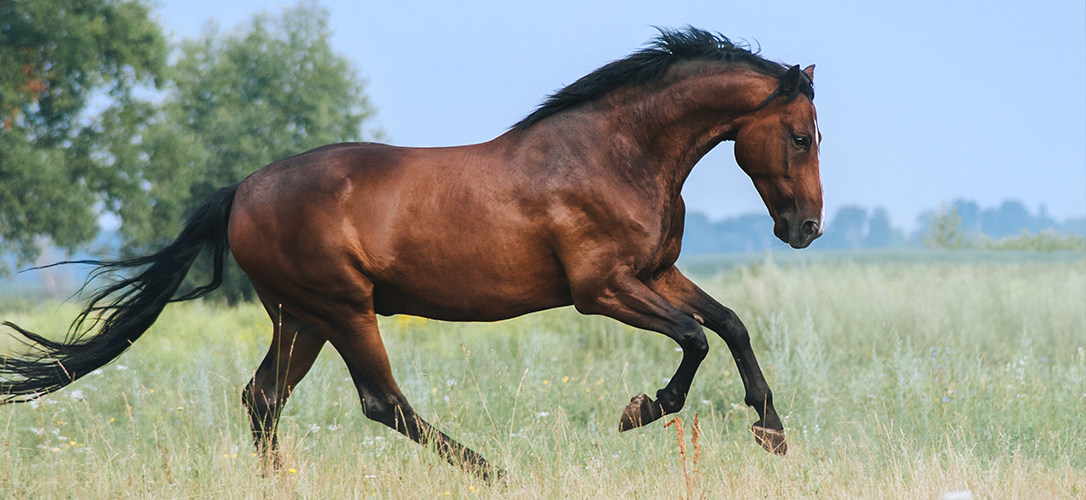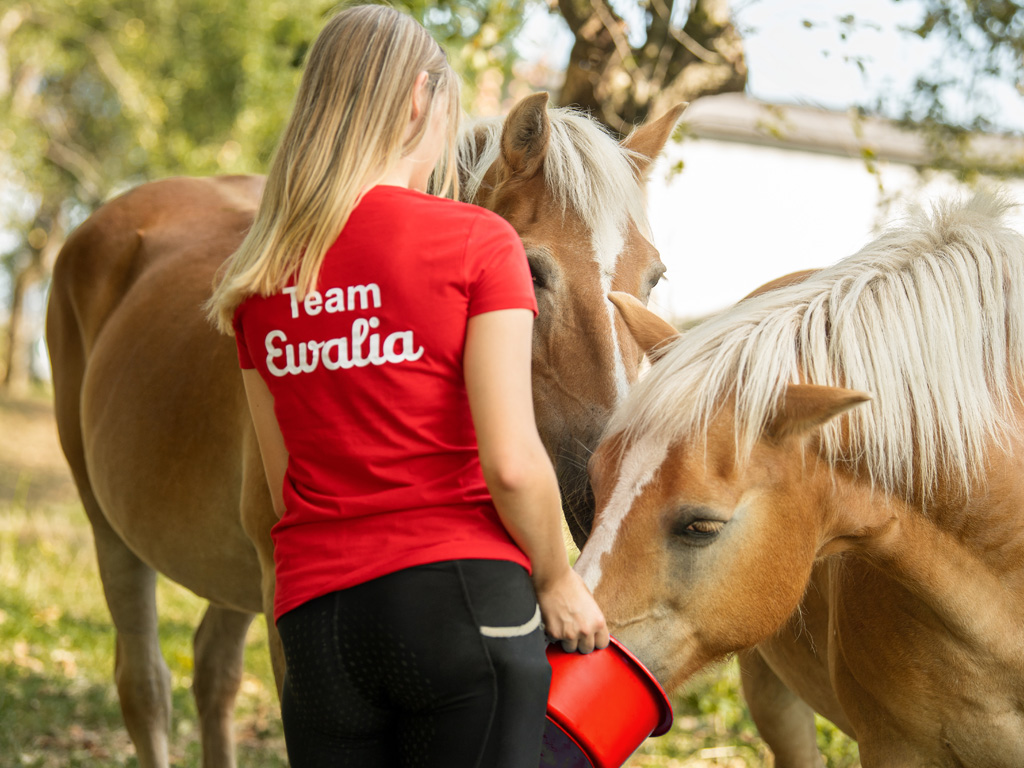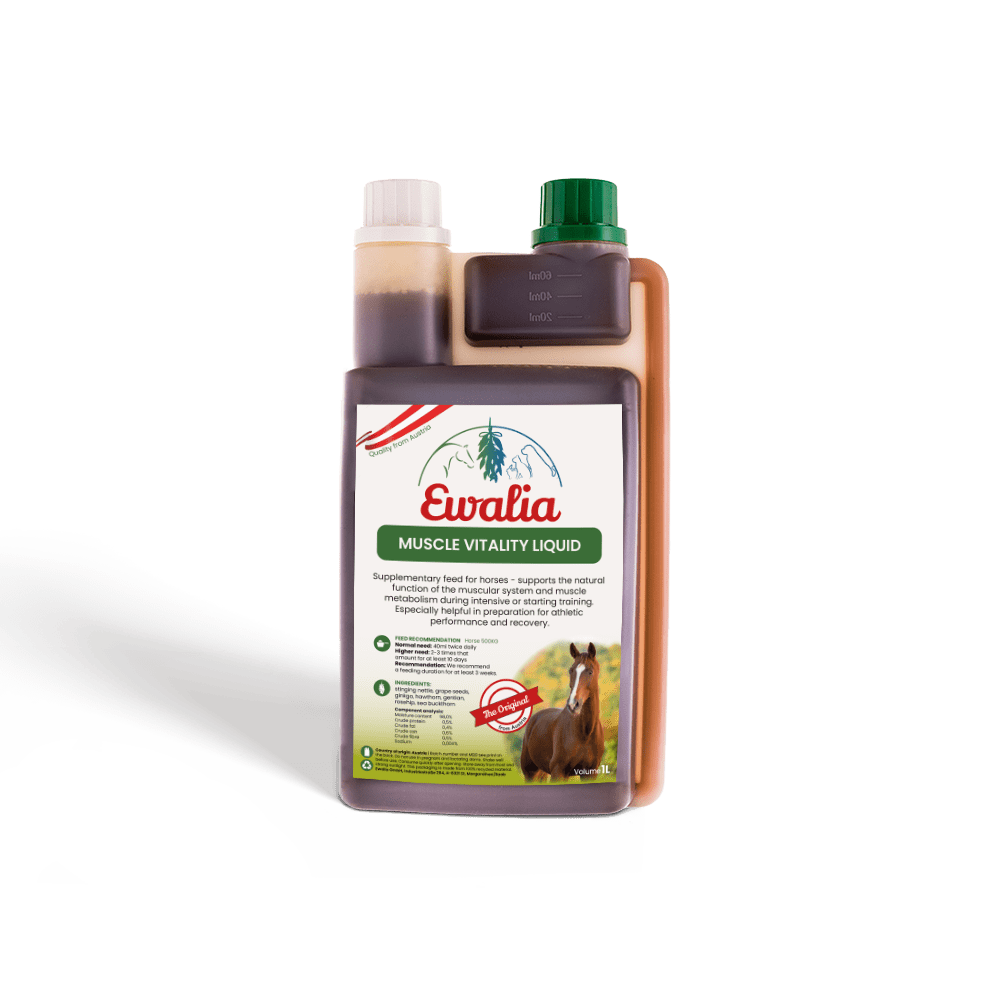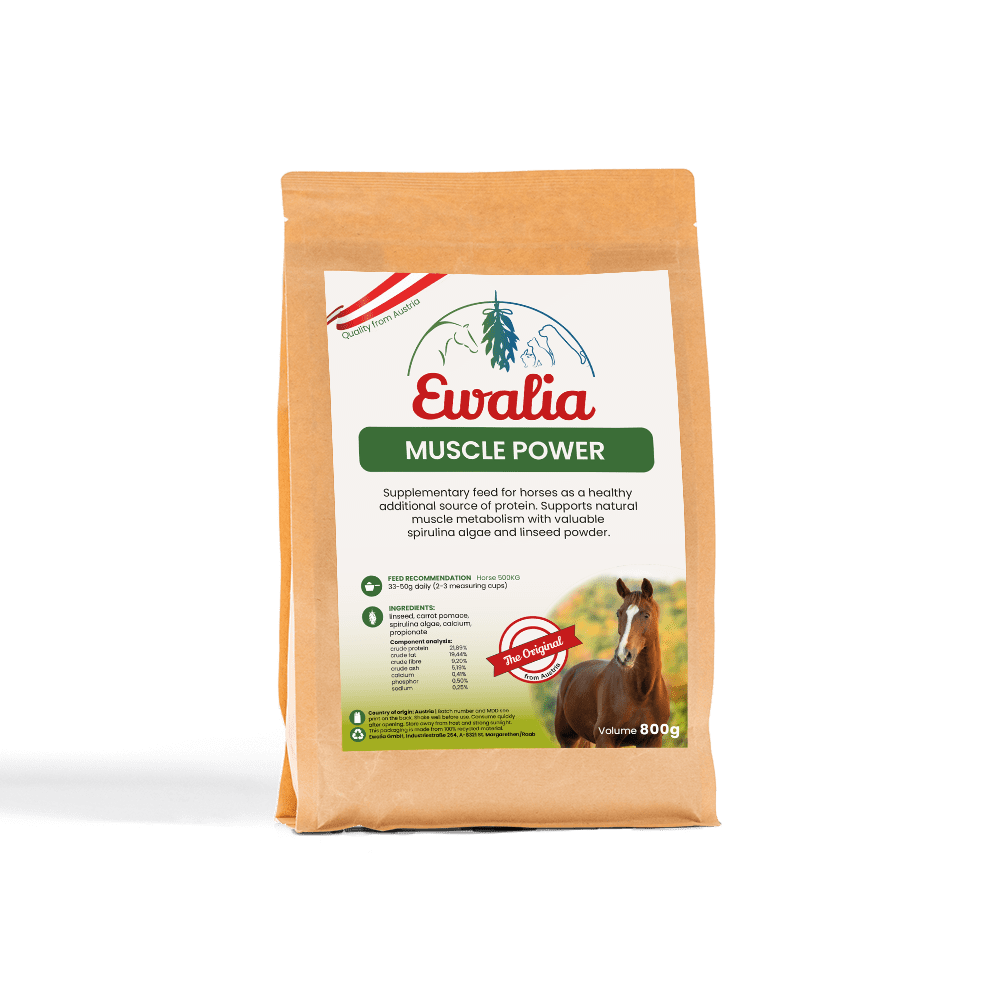Muscle development in horses

The most famous athletes have them. They are an absolute must for sporting achievement: the right muscles. The main purpose of the various muscle groups of the horse is to transform it from being a grazing horse to a riding horse. Regardless of whether you're jumping, doing dressage or other riding disciplines: Musculature is the most important requisite for maintaining the horse's health. Read on to see how you can support muscle building in your horse naturally.
The musculature of the horse
In order to build up a healthy musculature at all, regular and targeted training is indispensable. This doesn't only apply to humans, but also to our four-legged friends, our horses. The right muscles are responsible for the powerful jumps of a showjumper, the explosive and spontaneous power of the Western horse, the speed of a trotter, the condition of an endurance horse and the fine leg motor skills of a dancing dressage horse. A trained dressage horse resembles a body-builder; a trained racehorse, on the other hand, a marathon runner. The differences lie in the different muscle groups that are challenged and trained in the respective disciplines.
The musculature of the horse is divided into three different types of muscle:
- The heart musculature is known as the engine that drives circulation.
- The smooth muscle is responsible for the internal organs e.g. of the digestive system.
- The skeletal musculature is responsible for a variety of movements.
To properly prepare the horse for future tasks and lessons, it is important to understand how a horse's muscular system functions and works. Different processes in the horse's body are called on to ensure that the extra weight of the rider can be borne without problems. Untrained horses are often overwhelmed by the rider's weight, which represents an enormous physical strain. This strain is exacerbated when the rider's seat is unbalanced and disturbs the animal's balance. In this case, the horse not only has to perform a great physical, but also a mental feat to compensate for the rider's lack of control of his body. The concentration required for constantly having to rebalance itself is enormous.
The resulting overload should not be underestimated. Repeated overstraining of body and mind quickly leads to an undesirable protective posture, erroneous movement patterns and build-up of unwanted muscles. Overload leads to hardening, which in turn results in poorer circulation to the muscle groups, which restricts muscle metabolism. The result is pain, joint blockages, conspicuously rapid wearing out of joints and osteoarthritis.
Since for us riders a long, healthy life of our horse is a priority, it is quite clear that the lifespan and resilience of our animals depend on a well-defined musculature. So how can we support proper, constructive muscle training from the inside to keep our riding horses healthy and resilient for as long as possible?
Correct nutrition promotes muscle development
The acid-alkaline balance is one of the most important components of the musculature. In the case of hyper-acidity, there is no muscle growth, or it is slowed down considerably. A pH value that is too low slows down the metabolism of muscle cells.The supply of nutrients to all the muscles is significantly lower and causes a delayed development process. Both the acid-alkaline balance and the metabolism are influenced by what we feed our horses.
On the rider scene supplements are readily used to effect rapid muscle building. So what do muscle cells actually need to deliver good performance?
- proteins
- amino acids
- Vitamins E and C
- minerals and
- antioxidants.
These are the main ingredients needed for muscle building and maintaining good health. Effects such as increased and improved energy reserves, increased muscle mass and better and faster recovery from overuse have been observed when using the various dietary supplements that are fed to improve muscle growth . It should be noted, however, that hay alone (high quality), oats, alfalfa, special herbs, linseed oil and spirulina algae promote muscle growth in a natural way. In this context, spirulina algae are of special note because of their exceptionally high amino-acid content.
Feeding haylage, silage, sugar-containing feed such as beet pulp, maize, mueslis that contain molasses and feed that contains starch is not recommended, as these do not have a beneficial effect on muscle growth. In the next section we will look at why proteins, and not starch and sugar, promote muscle growth.
Proteins in the body of the horse
Proteins are chains of individual amino acids and are crucial for muscle growth. In short, proteins are the building blocks of the horse's body and are involved in all its functions. Among other things, they are responsible for cell division, digestive enzymes and the production of red blood cells. Every day, billions of new proteins have to be produced by the body to maintain body function. For this, the body requires a variety of amino acids (essential amino acids can only be absorbed via the feed), which combine to form gigantic protein molecules.
Muscles develop and muscle cells grow when targeted demands are placed on them. The muscle fibres are stressed and sometimes overloaded on a small scale (mini trauma). This "stress" triggers the metabolism of the muscle cells, which simply put then stock up on proteins, multiply their nuclei and increase their DNA. Biochemically it's a very complex process, but one that needs amino acids or proteins more than anything else.
Horse and feed experts agree that for the majority of horses grass and hay are sufficient as a constant source of protein and contain all he essential amino acids that the body needs. For targeted muscle development, it is advantageous if the required substances such as amino acids, vitamins, etc. are available quickly and adapted to the body's needs. In the body-building scene, especially, a customised diet is regarded as essential for success. The body of the horse, by comparison, can store amino acids for only one day, and is therefore dependent on daily replenishment of reserves.
That's why we've developed two products that naturally support and accompany muscle development.
Ewalia Muscle Package and Muscle Liquid
Our horses' health and maintaining it is very important to us, which is why we have created two products specifically aimed at promoting and supporting muscle development. The high-quality products are produced on a daily basis by employees with special expertise!
Ewalia Muscle Package is a supplement (powder) that contains linseed powder and spirulina algae. Spirulina algae have a high amino-acid and protein content, which promotes muscle development in conjunction with daily training.
Ewalia Muscle Liquid is a high-quality herbal extract. It provides support for tense muscles, relaxes the muscles after training and also promotes muscle growth. The carefully selected pharmacy-grade ingredients, such as nettle, grape seed, hawthorn, ginkgo, gentian, rosehip and sea buckthorn, are known to stimulate muscle metabolism.The natural sources of Vitamin E and Vitamin C that it contains also support the immune system.
Details on herbs and natural substances for muscle building
Stinging nettle
Stinging nettle relieves strain on the musculature. It contains many minerals like potassium and iron.
Grape seed
Because of their ingredient known as OPC, grape seeds are considered "super-antioxidants". The following effects are attributed to grape seeds: vascular protection, vascular regeneration, antioxidant and anti-inflammatory.
Ginkgo
Ginkgo is known to improve memory and blood circulation. Ginkgo extract makes blood more fluid. Because the blood circulates better in the fine vessels (microcirculation), the oxygen and nutrient content of the cells is stimulated. Ginkgo also protects nerve cells. It counteracts the breakdown of nerve cells and increases the efficiency of existing cells.
Hawthorn
Hawthorn has a significant effect on muscle tension and strength. OPCs have antioxidant and anti-inflammatory effects and are believed to act as catalysts that enhance the effects of Vitamins A, C and E. Certain ingredients in hawthorn are credited with improving the perfusion of heart muscle and coronary vessels and optimising oxygen and energy consumption.
Gentian
The main effect of yellow gentian is based on the bitters contained in the roots, so it was discovered very early as a medicinal plant. These bitter substances make gentian root a strong stomach remedy for promoting digestion and thus have a positive effect on the strength of the body.
Rosehip
Various healing effects are attributed to rosehips. A considerable part of this is due to the Vitamin C contained in large quantities in the sour fruits. Rosehip has the following effects: it strengthens the immune system, has a slightly dehydrating effect, forms new immune cells and other body cells, strengthens the connective tissue and contains essential oils, silicic acid, the antioxidants lycopene and flavonoids, the vitamins Provitamin A, Vitamins B1 and B2 as well as Vitamin E, the minerals zinc, copper, sodium, phosphorus, iron, calcium and magnesium.
Sea buckthorn
The Vitamin C powerhouse for health. Sea buckthorn contains a high percentage of Vitamin E and Provitamin A. Due to its high palmitoleic acid content, the body is able to absorb these vitamins quickly. The polyunsaturated fatty acids in the pulp are subdivided into omega-3 fatty acids and omega-6 fatty acids. Sea buckthorn is also said to have an anti-inflammatory effect. The red-golden berries contain numerous minerals, vitamins and trace elements such as calcium, potassium, magnesium, iron or zinc, Provitamin A (beta-carotene) and Vitamins B1, B2, E and K.
Compiled by: Bianca Becker-Slovacek on 21/01/2018















